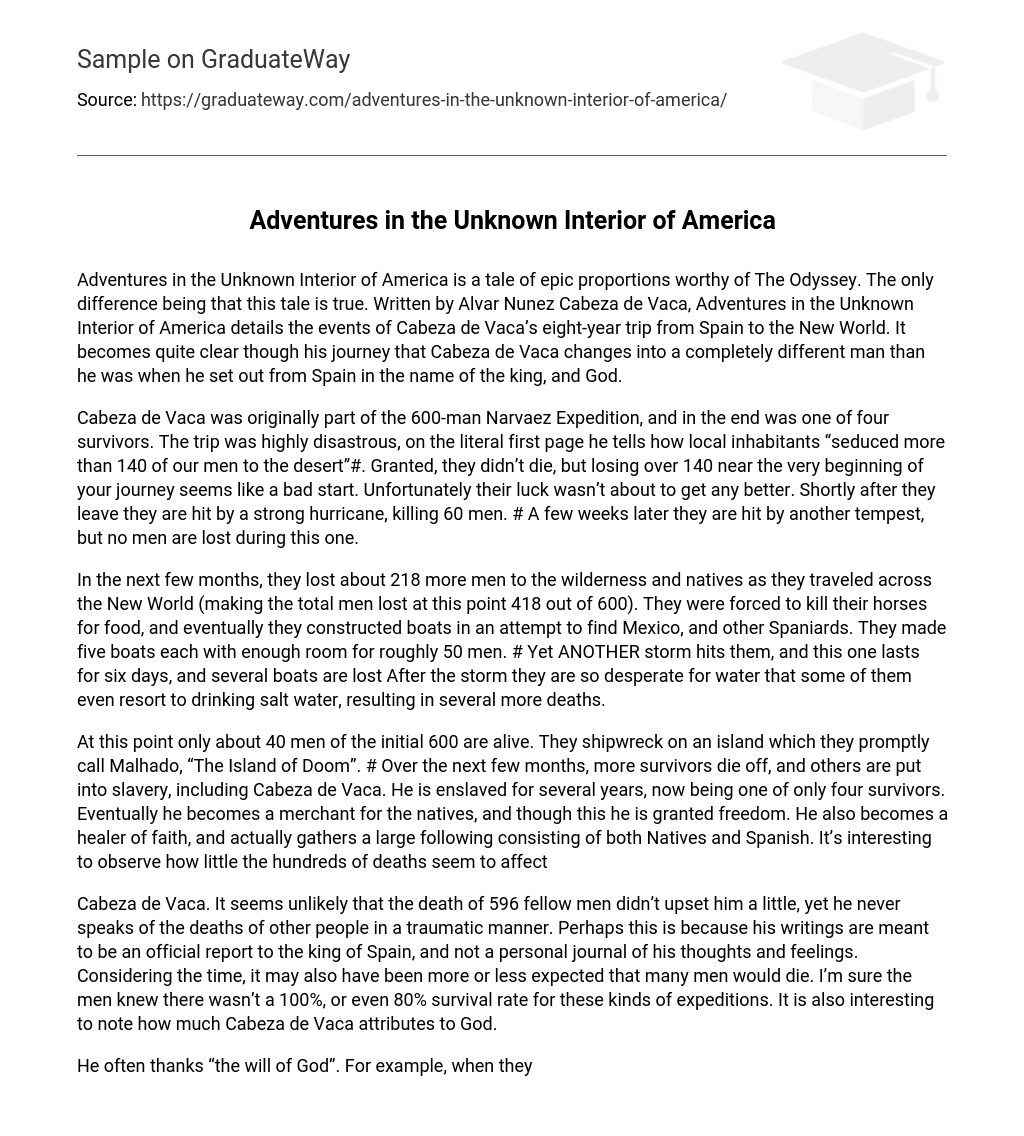Adventures in the Unknown Interior of America is a tale of epic proportions worthy of The Odyssey. The only difference being that this tale is true. Written by Alvar Nunez Cabeza de Vaca, Adventures in the Unknown Interior of America details the events of Cabeza de Vaca’s eight-year trip from Spain to the New World. It becomes quite clear though his journey that Cabeza de Vaca changes into a completely different man than he was when he set out from Spain in the name of the king, and God.
Cabeza de Vaca was originally part of the 600-man Narvaez Expedition, and in the end was one of four survivors. The trip was highly disastrous, on the literal first page he tells how local inhabitants “seduced more than 140 of our men to the desert”#. Granted, they didn’t die, but losing over 140 near the very beginning of your journey seems like a bad start. Unfortunately their luck wasn’t about to get any better. Shortly after they leave they are hit by a strong hurricane, killing 60 men. # A few weeks later they are hit by another tempest, but no men are lost during this one.
In the next few months, they lost about 218 more men to the wilderness and natives as they traveled across the New World (making the total men lost at this point 418 out of 600). They were forced to kill their horses for food, and eventually they constructed boats in an attempt to find Mexico, and other Spaniards. They made five boats each with enough room for roughly 50 men. # Yet ANOTHER storm hits them, and this one lasts for six days, and several boats are lost After the storm they are so desperate for water that some of them even resort to drinking salt water, resulting in several more deaths.
At this point only about 40 men of the initial 600 are alive. They shipwreck on an island which they promptly call Malhado, “The Island of Doom”. # Over the next few months, more survivors die off, and others are put into slavery, including Cabeza de Vaca. He is enslaved for several years, now being one of only four survivors. Eventually he becomes a merchant for the natives, and though this he is granted freedom. He also becomes a healer of faith, and actually gathers a large following consisting of both Natives and Spanish. It’s interesting to observe how little the hundreds of deaths seem to affect
Cabeza de Vaca. It seems unlikely that the death of 596 fellow men didn’t upset him a little, yet he never speaks of the deaths of other people in a traumatic manner. Perhaps this is because his writings are meant to be an official report to the king of Spain, and not a personal journal of his thoughts and feelings. Considering the time, it may also have been more or less expected that many men would die. I’m sure the men knew there wasn’t a 100%, or even 80% survival rate for these kinds of expeditions. It is also interesting to note how much Cabeza de Vaca attributes to God.
He often thanks “the will of God”. For example, when they are fortunate enough to find land. # Cabeza de Vaca changed drastically though his journey. When he starts off he’s very much focused on doing this for God and king, but he slowly becomes less concerned with that. He also develops a more accepting and worldly mind. When he first meets Native Americans he terrified that they’re going to sacrifice him#, because that’s the stereotype of the natives, but they are in fact very kind and offer him and his men fish and roots to eat.
However, the Cabeza de Vaca from the end of the book would know better. He develops a lot of empathy for the natives and their plight at the hands of the Spanish, because of the many years he spends in slavery. Towards the end of his journey Cabeza de Vaca possibly can relate to Native Americans more and better than his own people. There is no way he views them as savages at this point. By now he views them as a distinctive and unique culture. Not inferior, just different. Cabeza de Vaca also must feel guilty for how they have been mistreated by the Spanish.
It’s easier to feel justified for killing and enslaving a culture if you believe they are savages, and inferior to your culture. Thankfully Cabeza de Vaca came to realize that the Native Americans were real people with real feelings just as much as the Spanish were. As mentioned above, eventually Cabeza de Vaca freed himself from slavery by becoming a merchant. This allowed him to become accustomed with several different Native American tribes. The Cabeza de Vaca who left Spain was very different from the Cabeza de Vaca that went back. The Cabeza de Vaca that left from Spain had a sheltered view of the world.
What he knew of the New World was only the stereotype that most Spaniards had of the New World. That it was inhabited by savages, who were not fit to be treated like normal people, let alone equals. The Cabeza de Vaca who left the New World had a far better understanding of the world as a whole, and all it’s people. He realized how unjust it was to assume you were superior over another culture just because they were different. The Cabeza de Vaca who left from Spain was more caring, and more sympathetic towards others, and barely recognizable to the Cabeza de Vaca that left from America.





